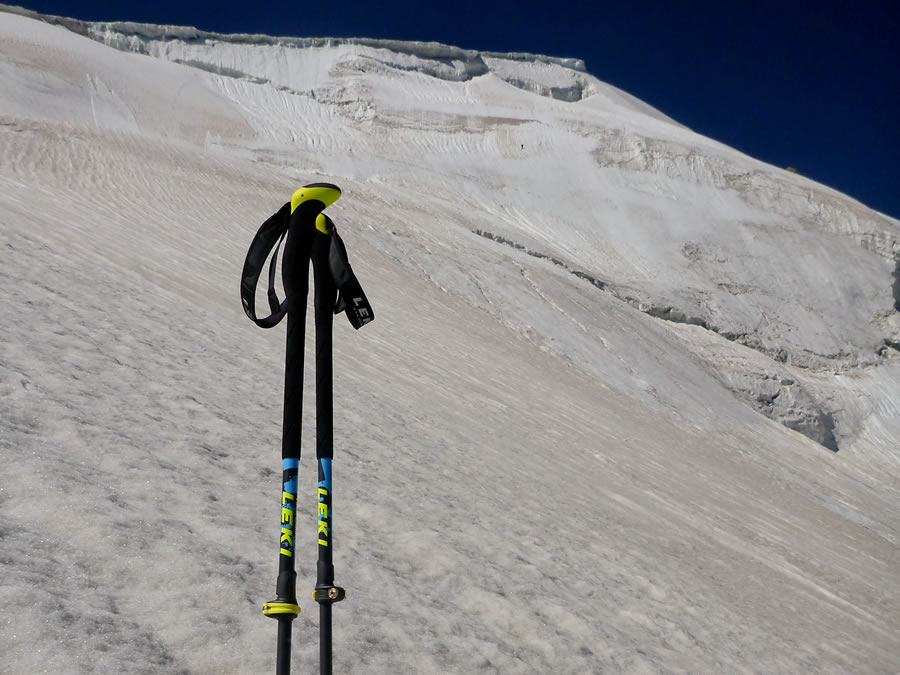Leki Tour Carbon 3 Review
Published on UKClimbing.com - January 2016
There are many ways to wreck a pair of poles.
My favoured approach is to pick a course back and forth across huge piles of unstable moraine whilst carrying a large and overloaded pack. With that in mind, I took a pair of Leki’s Tour Carbon 3 poles out on expedition to Tajikistan to give them a good beating. They are a high end pair of telescopic, three-piece poles aimed at both touring and mountaineering and this review is focused specifically on their use for trekking and mountaineering.
“They are a high end pair of telescopic, three-piece poles aimed at both touring and mountaineering.”



Shafts
Like anything, selecting poles is a trade-off between many factors, a key one here being stiffness and bending resistance vs. weight. Leki’s approach has been to use carbon shafts for only the upper two portions of the pole whilst opting for aluminium for the lower half. This adds to the weight a little but makes for a pole less prone to damage, I think it’s a good compromise. What isn’t so great is the overall size of the poles, when fully collapsed they are still 70cm long which is noticeably longer than most other competitors and makes them harder to stow in a pack especially with the chunky grips and baskets.
Baskets and Grips
The baskets are a twin-shot moulding with a large base diameter which is very flexible, conforming easily to the surface beneath. There’s definitely no danger of the plastic cracking and although they didn’t come with any alternative (smaller diameter) baskets I think the flex makes them work equally well on rock and snow. One feature I do appreciate is the small lug of plastic on top of the baskets where the shaft tapers to help keep the collapsed pole from extending accidentally.
The grips are chunky, feel great and in particular the hatched pattern on the soft foam below the handle is an excellent choice of material and unbelievably grippy. The straps are labelled left and right as they overlap coming out of the grip in different directions although I couldn’t discern any difference at all between the two? They adjust with a standard lift-and-slide mechanism but I did manage to dislodge one of these somehow, resulting in the toggle level popping out of alignment with the main pin which has made adjusting that strap a lot harder.
“The grips are chunky, feel great and in particular the hatched pattern on the soft foam below the handle is an excellent choice of material and unbelievably grippy.”



Extension Locks
The most crucial mechanical system on the poles is the extension locks. The Tour Carbon poles have a lever system which is probably the most robust method out there for achieving complete flexibility on your pole length. Leki talk a lot about wanting to make the mechanism easy to handle and the handles are certainly big enough but the lip on the yellow lever is quite small and could have easily been larger to help flick it open in gloves. It did upset my sense of precision to have the numbers printed without any corresponding lines (where do I align for 125cm? above the number? in line with the number?) but the over-centre lock on the levers is solid and after setting them up I had no issues with the poles collapsing accidentally. The screws on the reverse to tighten the clamp are some of the best I’ve seen and you don’t need a screwdriver to adjust them, any sort of blade will do.
Verdict
Over the years I have bent and then retired quite a number of poles and in Tajikistan I spent several hours bodging together my partner’s collapsible, fixed-length pair whose string mechanism had disintegrated. The Leki Tour Carbon 3 aren’t the most compact to stow, owing to the large baskets and long compressed length, but they feel robust, solid and best suited to the kinds of trips where you might compromise on weight and size to make sure your poles will last. The only caveat on this is the price – for almost £140 a pair I’d have hoped they would have been close to perfect and the price likely reflects their target market of touring and back country travel. I’ll be taking them out again this winter where I expect them to perform very well on skis but I whilst I can definitely recommend them as a solid piece of kit I imagine if you’re looking for a trekking-only pole the same level of robust engineering may be found elsewhere at a cheaper price.
“I imagine if you’re looking for a trekking-only pole the same level of robust engineering may be found elsewhere at a cheaper price.”